Picard7462
ACCESS: Restricted
- Joined
- 25 June 2019
- Messages
- 1
- Reaction score
- 6
12 - Artist's impression of 6 km-range Roland SAM system
mounted in self-contained module on a Caterpillar Goer vehicle.
Hughes and Boeing are Americanizing the Euromissile system for
US Army, and Norway has recently placed an order for this version.
Module has to be removed from Goer for airlift in a C-141.
The U. S. version of the ROLAND II, however, would be mounted on the GOER vehicle . The plan was to deploy the ROLAND II SHORAD system with troops in central Europe to defend
rear-area, high-value targets, such as airfields, depots, ports, troop encampments, and other support and combat facilities. A DSARC decision on its assignment to Army divisions was yet to be made.
uk75, in all due respect, appreciating the practicality of the German's (well most of the time), I'd think the Bundeswehr fully appreciated the Leopard 1/Gepard combination better than anyone else in terms of operational capability. As much as I appreciate the notion of commonality/logistics of the Gepard turret being fitted to the Leopard 2 chassis, I'm thinking the cost of new Leopard 2 chassis and the engineering outweighed the notion of continuation of the legacy Leopard 1/Gepard being kept as it was - 'if it's not broken, don't fix it'Back in the late 1960s, the West Germans commissioned a paper study and model work to see if the anti air weapons proposed for the Leopard 1 (Fla Pz Gepard) could be fitted to the KPZ 70, which was planned to replace the M48 in FRG service.
Because of the failure of the MBT/KPZ 70 nothing materialised. However, if the project had gone ahead, this would have been a great opportunity for the US and West Germans to standardize kit.
However, as the Gepard was never mated with the later Leopard 2 (KPZ 70s actual replacement) perhaps not.
But, I love paper studies, so maybe out there....
Pioneer
You are right about Leopard 2 and the Gepard turret, as I pointed out this was never an option.
The MBT70/KPZ70 was originally only intended to replace the M48 as Leo 1 had replaced the Heer M47s.
It never came close to entering service. But assuming the study was done as the German book on Deutsche Flakpanzer suggests, then a Gepard or Matador turreted KPZ70 was at least theoretically possible.
You could certainly say it was a show stopper at least.
From what I understood about this is that it had some flaws, some of those flaws were being rectified, and all it really needed was 5k PSI hydraulics, slapped onto an M60 chassis, barrels that weren't simply worn out because some dumb idiot wanted to be a cheapskate and not order a few dozen 40mm barrels, tweak the fire control a bit more, and it would have been scaring the shit out of USSR helicopter pilots.Tom Farrier Retired USAF rescue helicopter pilot; current aviation safety contractor (UAS) said:In 1982 I participated in both cooperative and non-cooperative tests at Aberdeen Proving Grounds in Maryland, flying an Air Force CH-3E helicopter against a Sergeant York. I would have been dead many times over had it been shooting live rounds at us instead of just video.
The Sergeant York was the front-runner in a program intended to provide the Army with a sorely needed “division air defense” (DIVAD) weapon system. It was based on a novel concept: re-purposing M48 Patton tank chassis’ with a new turret incorporating twin Swedish Bofors 40mm cannons and two radar systems — one for area surveillance (the rectangular antenna) and one for targeting (the conical antenna, an off-the-shelf application of the F-16′s radar).
A firing control system integrated the two radars, with on-board software prioritizing targets based on the threat they were assessed to pose to the system itself. (For the late ’70s /early ’80s, this was cosmic.) If the operator elected to allow the system to engage targets hands-off, it would slew the turret around at a nauseatingly rapid rate, taking on each in turn automatically.
On the next-to-last day of the test, my aircraft was joined by an Army AH-1 Cobra and OH-58 Kiowa and two Air Force A-10s. My H-3 was part of the test profile because its radar signature was essentially the same as that of an Mi-24 HIND assault helicopter of the day, which was heavily armed with both anti-tank missiles and rockets. We all converged on it simultaneously from about 6000 meters. My aircraft was the first to die, followed by the two A-10s, then the Cobra, and finally the Kiowa. It took less than 15 seconds to put plenty of hypothetical rounds into each of us.
I spent a depressing amount of that week watching myself get tracked and killed on video. Trying to “mask” behind anything other than rising terrain simply didn’t work; the DIVAD radar got a nice Doppler return off my rotor system if any part of it was within its line of sight, and it burned right through trees just fine. I couldn’t outrun or out-maneuver it laterally; when I moved, it tracked me. I left feeling pretty convinced that it was the Next Big Thing, especially since I’d come into the test pretty cocky thanks to having had a lot of (successful) exercise experience against current Army air defense systems.
So, what happened to the program itself? I think it was a combination of factors. First, the off-the-shelf concept was cool as far as it went, but the Patton design already was a quarter-century old; the DIVAD was awfully slow compared with the M1 Abrams tanks it was supposed to protect. It would have had a lot of trouble keeping up with the pack.
Second, The Atlantic Monthly published a really nasty article (bordering on a hatchet job) purporting to show the program was a complete failure and a ruinous waste of money. One of its most impressive bits of propaganda was an anecdote about a test where the system — on full automatic — took aim at a nearby trailer full of monitoring equipment. Paraphrasing, “It tracked and killed an exhaust fan,” chortled the author. (See The Gun That Shoots Fans for a recounting of this.)
Yeah, it did. It was designed to look for things that rotate (like helicopter main rotor systems) and prioritize them for prompt destruction. If any bad guys were on the battlefield in vehicles with unshrouded exhaust fans, they might have been blown away rather comprehensively. (My understanding at the time was that said fan was part of a rest room in one of the support vehicles and not a “latrine,” but why mess up a good narrative, right?)
To my knowledge, neither ventilated latrines nor RVs full of recording devices are part of a typical Army unit’s table of allowance, so I really doubt there was much of a fratricide threat there. However, the bottom line was that this particular piece of partisan reporting beat the crap out of a program that I believe the Army needed, but already was facing a few developmental issues, and helped hasten its cancellation.
(The New York Times opinion piece linked to above was equally laden with innuendo and assumptions. It made a fair point about possible anti-radiation attacks it might have invited… but there are radars on every battlefield, and there are means of controlling emissions. It compared a late-Fifties era Soviet system — the ZSU-23–4 — with one fully twenty years newer in design. It asserted that it couldn’t hit fixed-wing aircraft, which to my mind and personal observation was arrant nonsense. The only issue it raised that I agree with was possible NATO compatibility problems with the unique 40mm caliber shells the Sergeant York’s guns fired. Funny — the Times pontificated that it wouldn’t be cancelled, too. Oops.)
Third, the hydraulics that were used in the prototype were a 3000 psi system that really couldn’t handle the weight of the turret in its Awesome Hosing Things mode. One of the only times I actually got a score on the system was when I cheated; I deliberately exploited that vulnerability. I flew straight toward the system (which would have blown us out of the sky about twenty times over had I tried to do so for real) until directly over it, then tried to defeat the system from above.
If memory serves, the system specifications called for the guns to elevate to more than 85 degrees if something was coming up and over; it then would lower them quickly, slew the turret 180 degrees around, and raise the guns again to re-engage. It was supposed to be able to do that in perhaps ten seconds (but I’m here to tell you it did it a lot faster than that). So, I had my flight engineer tell me the moment the guns dropped, at which point I did a course reversal maneuver to try to catch it pointed the wrong way. What the video later showed was:
The hydraulics hadn’t been able to support the multiple close-on, consecutive demands of movement in multiple axes and failed. Like I said, I cheated. The Army and the contractors already knew about this problem and were going to fit out production models with a 5000 psi system. That might have had some survivability issues of its own, but the Army was perfectly happy that we’d done what we did — it proved the test wasn’t rigged and underscored the need for the production change.
- Helicopter flies over.
- Traverse/re-acquire movement starts.
- Helicopter initiated hammerhead turn (gorgeous, if I say so myself).
- Guns started to elevate to re-engage.
- Clunk. Guns fall helplessly down; DIVAD crew uses bad language.
Finally, the Army itself honestly appraised the system based on its progress (and lack of progress) versus their requirements. Wikipedia provides a passage that encapsulates this end-game well: “The M247 OT&E Director, Jack Krings, stated the tests showed, ‘...the SGT YORK was not operationally effective in adequately protecting friendly forces during simulated combat, even though its inherent capabilities provided improvement over the current [General Electric] Vulcan gun system. The SGT YORK was not operationally suitable because of its low availability during the tests.’ ”
I guess I’m forced to conclude that the Sergeant York was a really good concept with some definite developmental flaws — some recognized and being dealt with, perhaps one or two that would have made it less than fully effective in its intended role — that was expensive enough for bad PR to help bring it down before it fully matured. The Army was under a lot of political pressure to get it fielded, but to their credit they decided not to potentially throw good money after bad.
On balance, a lot of the contemporaneous criticisms mounted against the M247 really don’t hold up very well over time. Short-range air defense currently is provided by the latest generation of the AN/MPQ-64F1 Improved Sentinel system. Radar emitting on the battlefield? Check. Target prioritization capabilities? Check. Towed (which equals “slow”) versus self-propelled? Check.
I’m glad we never wound up in the position of needing it but not having it. My personal judgment was and is that it probably could have wound up a heck of a lot more capable and useful than its developmental history might suggest, but its cancellation probably was justified given other acquisition priorities at the time.
Bottom line: I repeatedly flew a helicopter against it over the course of many hours of testing, including coming at it as unpredictably as I knew how, and it cleaned my clock pretty much every time.
Remember that this was an era when Bofors was offering a proximity-fuzed 40mm, while 35mm AHEAD was still decades in the future. At that moment, with that tech on offer, I'd say 40mm was clearly a better solution.Finally, the US Army should have utilised the longer-range and more accurate 35 mm Oerlikon KDA cannon instead of the legacy Bofors 40mm
From my understanding, the M48 was only chosen because the M60 was still the mainline tank at the start of the program. Then the M1 arrived. If I was able to be leading the program, one of the changes I would do (other than upgrading the hydraulics to 5k PSI units instead of the 3k) would swap the chassis. At least the M60 can keep up.As much as the US Army used the M48 chassis as a means of saving cost, could/would the M48-based Sgt York have been able to keep pase with the likes of the M1 and M2/3?
I'm also under the impression that the attempt to utilise a modified version of the Westinghouse AN/APG-66 from the GD F-16 Fighting Falcon.
I think the US Army had become somewhat gunshy with the notion of a start from scratch specialised scratch- design and built autonomous radar/fire-control system which was a nacesity for such an ambitious SPAAG system, that could engage aerial threats, whilst on the move. I'm of the opinion the US Army never got over their failings and criticism of their ambitious MIM-46 Mauler self-propelled battlefield SAM system. The fact that the US Army was not just prepared, but comfortable with a slapped together improvised 'Chaparral-Vulcan Air Defense System' before and after the Sgt York/"Division Air Defense" (DIVAD)d says loads to me how serious they were of battlefield air defence as part of their ORBAT.
Now the Soviet's had more than their fair share of terrible teething problems with their ZSU-23-4 "Shilka" SPAAG and 9K33 Osa self-propelled battlefield SAM system. But importantly, they persisted, and derived two world-class air defence systems, which have been tested and proven in numerous combat.
The Soviet's even went as far as totally redesigning the 9K33 Osa to fix it's original shortcomings.....And yet, the US Army threw in the towel.
Finally, the US Army should have utilised the longer-range and more accurate 35 mm Oerlikon KDA cannon instead of the legacy Bofors 40mm.
Regards
Pioneer
You've also got to understand that Congress has the purse strings and had various laws kitted to make such an avenue largely locked out. Also, 35mm guns are, um, poor, to say the least when it comes to anti-air work. Not only that but you've got the USAF in many of a politician's ears, making it harder for the US Army to get AAA systems. The only reason that the USN isn't a completely dilapidated mess is that the USN has a lot more pull thanks to it existing since the US was born. Basically, the similar situation Britain has when it comes to procurement (i.e. screw the army, only the navy and airforce only matters).As much as the US Army used the M48 chassis as a means of saving cost, could/would the M48-based Sgt York have been able to keep pase with the likes of the M1 and M2/3?
I'm also under the impression that the attempt to utilise a modified version of the Westinghouse AN/APG-66 from the GD F-16 Fighting Falcon.
I think the US Army had become somewhat gunshy with the notion of a start from scratch specialised scratch- design and built autonomous radar/fire-control system which was a nacesity for such an ambitious SPAAG system, that could engage aerial threats, whilst on the move. I'm of the opinion the US Army never got over their failings and criticism of their ambitious MIM-46 Mauler self-propelled battlefield SAM system. The fact that the US Army was not just prepared, but comfortable with a slapped together improvised 'Chaparral-Vulcan Air Defense System' before and after the Sgt York/"Division Air Defense" (DIVAD)d says loads to me how serious they were of battlefield air defence as part of their ORBAT.
Now the Soviet's had more than their fair share of terrible teething problems with their ZSU-23-4 "Shilka" SPAAG and 9K33 Osa self-propelled battlefield SAM system. But importantly, they persisted, and derived two world-class air defence systems, which have been tested and proven in numerous combat.
The Soviet's even went as far as totally redesigning the 9K33 Osa to fix it's original shortcomings.....And yet, the US Army threw in the towel.
Finally, the US Army should have utilised the longer-range and more accurate 35 mm Oerlikon KDA cannon instead of the legacy Bofors 40mm.
Regards
Pioneer
This. That and the guns used are the older L/60s and not the newer L/70s (also, the barrels in the program were completely worn out...).Remember that this was an era when Bofors was offering a proximity-fuzed 40mm, while 35mm AHEAD was still decades in the future. At that moment, with that tech on offer, I'd say 40mm was clearly a better solution.Finally, the US Army should have utilised the longer-range and more accurate 35 mm Oerlikon KDA cannon instead of the legacy Bofors 40mm
I respectively recognise your thoughts and opinion, my dear TomS.Remember that this was an era when Bofors was offering a proximity-fuzed 40mm, while 35mm AHEAD was still decades in the future. At that moment, with that tech on offer, I'd say 40mm was clearly a better solution.Finally, the US Army should have utilised the longer-range and more accurate 35 mm Oerlikon KDA cannon instead of the legacy Bofors 40mm
It should be noted that the DIVAD program had two 35mm entries, one that is essentially an American Gepard, and a rechambered Vigilante (aka Sprey and Company's 37mm-would-vibrate-itself-to-pieces-from-recoil-alone system.I respectively recognise your thoughts and opinion, my dear TomS.Remember that this was an era when Bofors was offering a proximity-fuzed 40mm, while 35mm AHEAD was still decades in the future. At that moment, with that tech on offer, I'd say 40mm was clearly a better solution.Finally, the US Army should have utilised the longer-range and more accurate 35 mm Oerlikon KDA cannon instead of the legacy Bofors 40mm
Regards
Pioneer
The Army and the contractors already knew about this problem and were going to fit out production models with a 5000 psi system.
Here's the thing, that's in line with what happened to the AH-56 before it got canned. A lot of the problems that were coming up had solutions but got canceled before implementation.The Army and the contractors already knew about this problem and were going to fit out production models with a 5000 psi system.
I don't doubt most of this story but this almost certainly isn't true.
True.Putting it on an M-60 hull would have been the best way to go.
But I am sceptical about "keeping up" with the M-1 would have been a serious problem in most combat scenarios. NATO tank formations would have been used largely for defensive manoeuvres in Europe for the first part of any Warpac invasion scenario. Even in counter-attack scenarios tanks move in leaps covered by others within the formation, no-one was going to drive full-tilt into belts of waiting Soviet ATGWs and guns and tanks like it was 1941 all over again. Let's not forget the Shikla only did around 19-20mph over rough ground, though the Tunguska chassis is quicker.
Here's the thing, that's in line with what happened to the AH-56 before it got canned. A lot of the problems that were coming up had solutions but got canceled before implementation.The Army and the contractors already knew about this problem and were going to fit out production models with a 5000 psi system.
I don't doubt most of this story but this almost certainly isn't true.
I remember there's 3 different 35mm plan.It should be noted that the DIVAD program had two 35mm entries, one that is essentially an American Gepard, and a rechambered Vigilante (aka Sprey and Company's 37mm-would-vibrate-itself-to-pieces-from-recoil-alone system.I respectively recognise your thoughts and opinion, my dear TomS.Remember that this was an era when Bofors was offering a proximity-fuzed 40mm, while 35mm AHEAD was still decades in the future. At that moment, with that tech on offer, I'd say 40mm was clearly a better solution.Finally, the US Army should have utilised the longer-range and more accurate 35 mm Oerlikon KDA cannon instead of the legacy Bofors 40mm
Regards
Pioneer
The 35mm was deemed -and would still be deemed- not lethal enough. Especially since the US Army also wants some infantry fire support capability (something that the M42 was well-liked for).
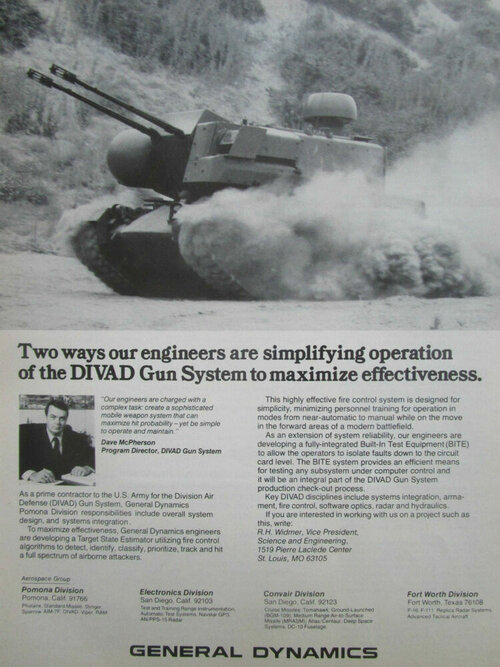
The contestants that I remember is GE's (which is, oddly enough, a GAU-8 in a turret mated with the radar set), the Vigilante that got rechambered (aka Sprey and Company's design), the Ford design (aka the Sgt. York), and the GD design (shown above).I remember there's 3 different 35mm plan.It should be noted that the DIVAD program had two 35mm entries, one that is essentially an American Gepard, and a rechambered Vigilante (aka Sprey and Company's 37mm-would-vibrate-itself-to-pieces-from-recoil-alone system.I respectively recognise your thoughts and opinion, my dear TomS.Remember that this was an era when Bofors was offering a proximity-fuzed 40mm, while 35mm AHEAD was still decades in the future. At that moment, with that tech on offer, I'd say 40mm was clearly a better solution.Finally, the US Army should have utilised the longer-range and more accurate 35 mm Oerlikon KDA cannon instead of the legacy Bofors 40mm
Regards
Pioneer
The 35mm was deemed -and would still be deemed- not lethal enough. Especially since the US Army also wants some infantry fire support capability (something that the M42 was well-liked for).
Sperry&Rand rechambered Vigilante
Raytheon Gepard turret
View attachment 660855
and General Dynamics T246
This prototype got better result in firing trial than Ford T247
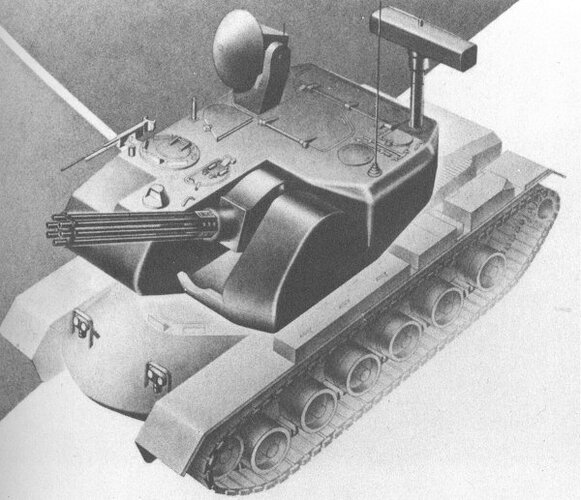
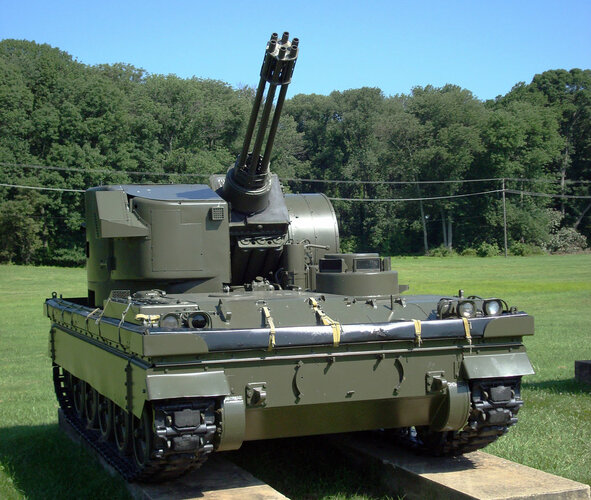
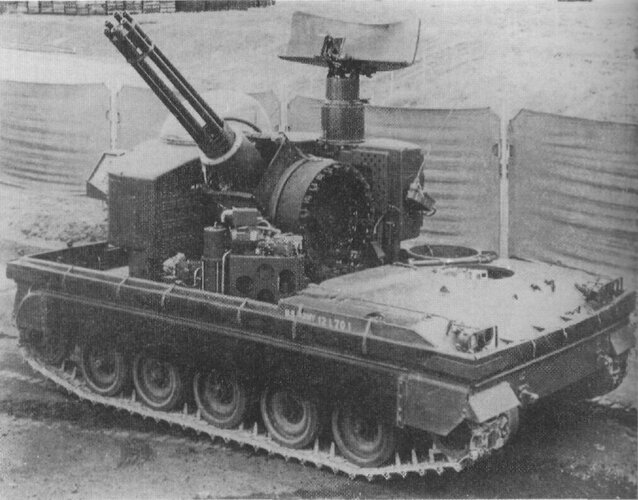
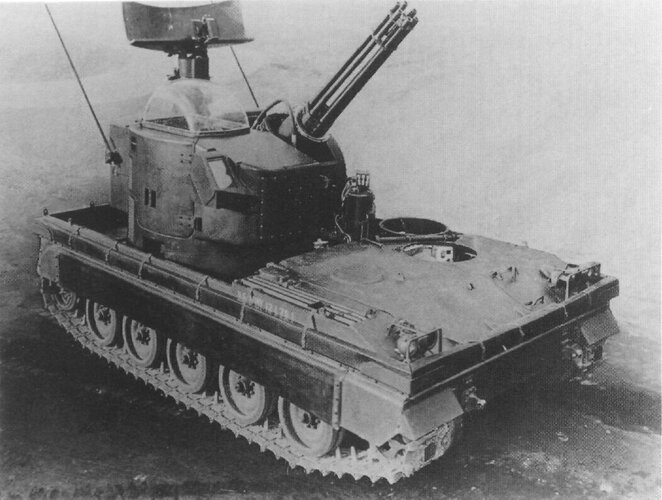
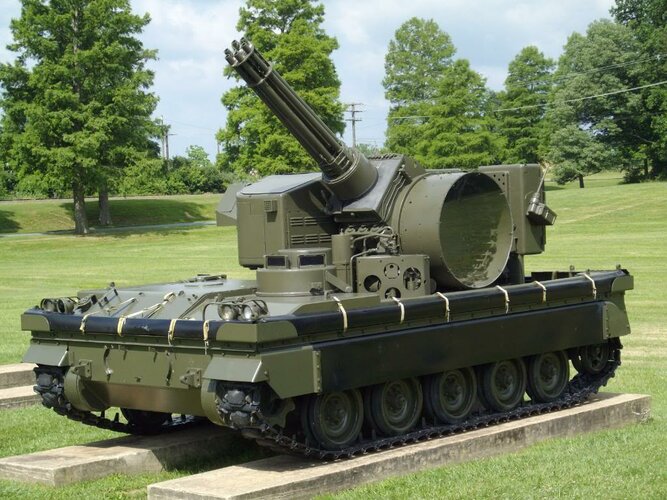
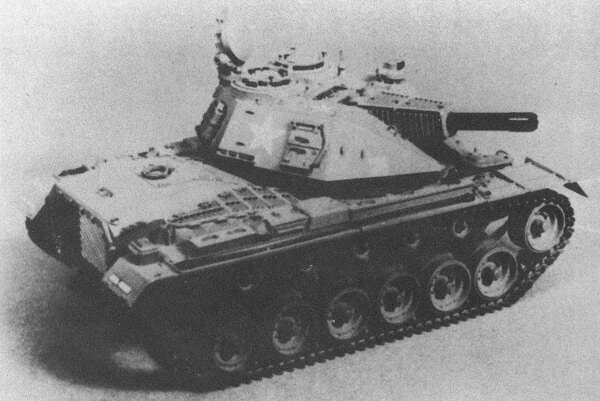
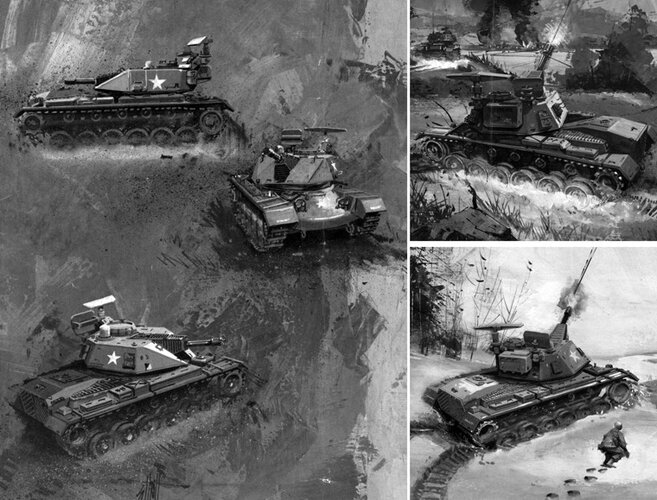
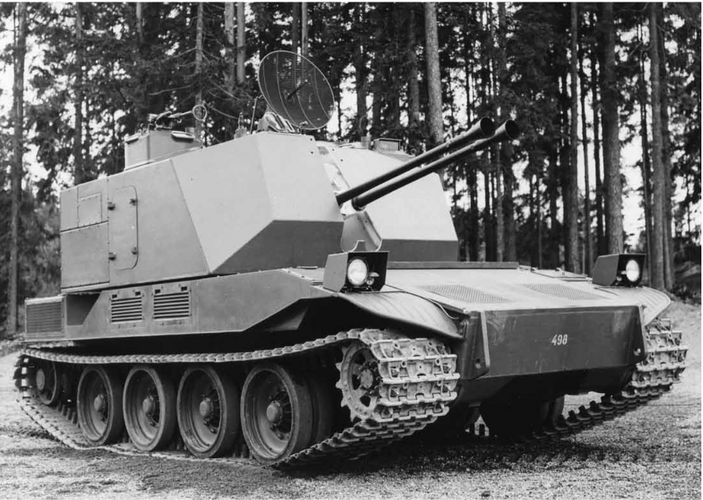
You also got to remember that the Vigilante had a disturbing tendency to literally shake itself apart in its original configuration, largely due to the recoil of the 37mm being so harsh.
Given the continued development of helicopter-launched ATGMs a vehicle like the Sergeant York would eventually have to operate in a close pairing with a missile-based forward SHORAD vehicle like the later ADATS. If you recognize this fact does the picture change to favor the smaller caliber faster firing cannons like the GAU-8/A?
I'd love to hear more about how the Vigilante performed. Unless I'm mistaken that's the largest caliber modern Gatling-type gun built.
Not really. Aircraft were getting hardened against small-caliber autocannon up to the 35mm range. 40mm or more are becoming the requirement. Even Russia is investing in large-caliber autocannons...Given the continued development of helicopter-launched ATGMs a vehicle like the Sergeant York would eventually have to operate in a close pairing with a missile-based forward SHORAD vehicle like the later ADATS. If you recognize this fact does the picture change to favor the smaller caliber faster firing cannons like the GAU-8/A?
I'd love to hear more about how the Vigilante performed. Unless I'm mistaken that's the largest caliber modern Gatling-type gun built.
Not really. From what I understand 20mm was way too impudent in the role that it was going to be thrown in, at least in this case. 20/23mm autocannon was just becoming obsolete during this time, mind you. They simply didn't have enough 'omph'.This kinda makes me think... i wonder if there is any stories on the XM-246, the one which based on Phalanx. I heard it fares better but no more than that.
Not really. From what I understand 20mm was way too impudent in the role that it was going to be thrown in, at least in this case. 20/23mm autocannon was just becoming obsolete during this time, mind you. They simply didn't have enough 'omph'.This kinda makes me think... i wonder if there is any stories on the XM-246, the one which based on Phalanx. I heard it fares better but no more than that.
This. That and the guns used are the older L/60s and not the newer L/70s (also, the barrels in the program were completely worn out...).
This kinda makes me think... i wonder if there is any stories on the XM-246, the one which based on Phalanx. I heard it fares better but no more than that.
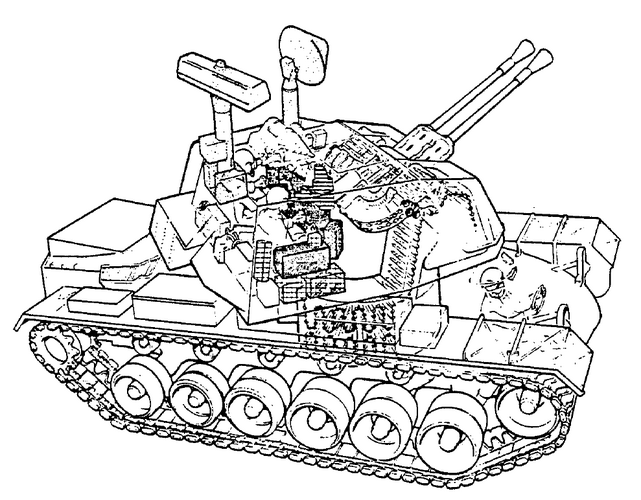
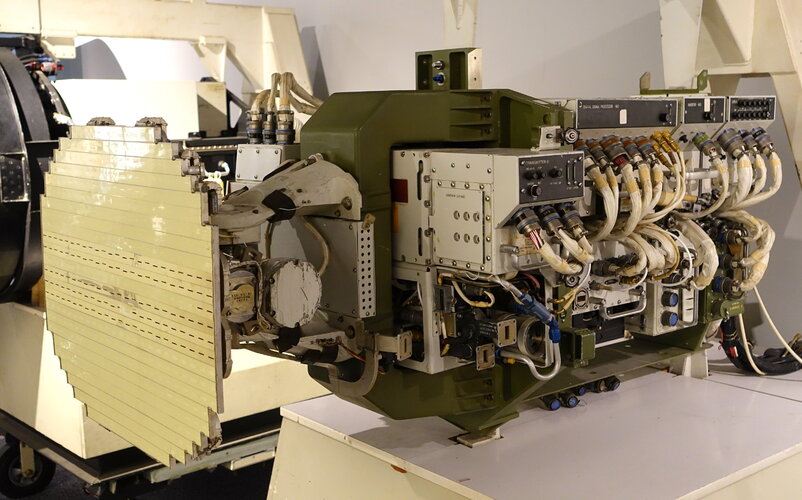
"A 5000 psi hydraulic system isn't a solution to anything in an armored vehicle, especially in the early 80s. It's not even more powerful, that's not how hydraulics work. The problem in the ITP's hydraulic system was leakage, not power. If the guns suddenly drop down it's because there's a leak and the hydraulic system has lost pressure."
- drejr, 2021
"Sgt. York's failures were nothing like the AH-56. They came almost entirely from the Army using a novel acquisition model with acknowledged risks on a complex project."
-drejr, 2021
The thing was that the problem is with... fine-tuning the radar and the FCS system with it. Remember, this was a significant breakthrough in SPAAG tech as the radar was designed to be basically 'if it is radar-opaque, then LoS answer is yes', and this was on top of the HEPF rounds being offered. For helicopters, this is absolutely deadly, as it means they can't just hide behind some trees and do 'pop up' attacks. That's why helicopter doctrine has shifted from their original doctrines to, effectively, 'stay behind the allied side of the frontline and spam indirect missiles at the enemy', the battlespace has made 'low and slow' to be deadly against anyone semi-competent.Was any thought given to replacing the M247 Sergeant York's problematic Westinghouse AN/APG-66 derived tracking radar with an alternate radar system?
